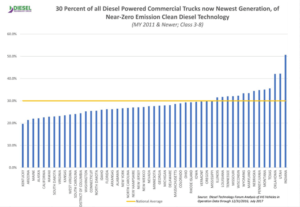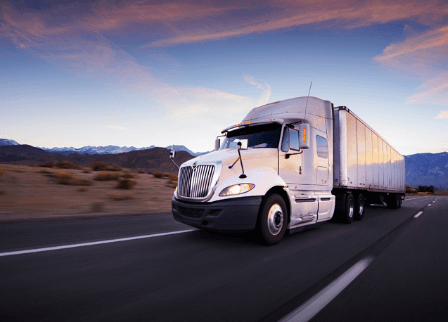Advanced clean diesel vehicles now make up 30% of all commercial trucks in operation in the U.S., yielding significant emission reductions and substantial fuel savings, according to new research commissioned by the Diesel Technology Forum.
The forum notes that Indiana, Utah and Oklahoma have the highest percentages of clean diesel trucks, at 51%, 42%, and 42%, respectively.
“Almost 3 million heavy-duty diesel commercial vehicles introduced in the U.S. from 2011 through 2016 are now on the road powered by the latest generation clean diesel engines, and these trucks have delivered important benefits in the form of cleaner air, fewer carbon dioxide emissions and dramatic fuel savings,” says Allen Schaeffer, executive director of the Diesel Technology Forum.
“Over a five-year period, the newest generation commercial vehicles have saved 4.2 billion gallons of diesel fuel and reduced 43 million tons of carbon dioxide (CO2), 21 million tons of nitrogen oxides (NOx) and 1.2 million tons of particulate matter.
“Because diesel overwhelmingly dominates the heavy-duty truck sector and is also the number one power source for medium-duty vehicles, the transition to newer generations of clean diesel technology (2011 and later MY) is significant,” he continues. “The 30 percent national average is up from just 25.7 percent last year. The research also estimated that significant further benefits would accrue to communities across the country if more of these newer generation clean diesel trucks enter into service.”
Schaeffer goes on to note that the state of California ranks 46th nationally, with only approximately 25% of commercial trucks there equipped with the latest generation clean diesel technology.
“If California were to achieve the same new technology penetration as Indiana (51 percent), it can eliminate another 200,000 tons of NOx and 11,000 tons of fine particles that would bring cleaner air faster to all California communities than any other strategies,” he says.
The benefits research was conducted by IHS Markit, a global technical marketing research firm headquartered in Southfield, Mich. State rankings data is based on Diesel Technology Forum analysis of IHS Markit vehicles in operation data representing Class 3-8 diesel trucks from Model Year 2011 through 2016 in all 50 states and the District of Columbia through Dec. 31, 2016.
“The U.S. trucking fleet is transitioning to newer clean diesel technology, which means immediate fuel savings, lower greenhouse gas emissions and cleaner air. This newest generation of clean diesel trucks have NOx emissions that are 99 percent lower than previous generations along with 98 percent fewer emissions of particulate matter, resulting in significant clean air benefits throughout the U.S.
“Beginning in 2011, all heavy-duty diesel trucks sold had to meet NOx emissions of no more than 0.20 grams per brake horsepower hour. This is in addition to particulate emissions levels of no more than 0.01 grams per brake horsepower hour established in 2007.
“Achieving these substantial emissions reductions and efficiency advancements was, in part, the result of collaboration of the nation’s leading truck and engine manufacturers working with the Department of Energy and 21st Century Truck Partnership’s ‘SuperTruck’ program,” says Schaeffer. “While the intent of this valuable program is to push the margins of research engineering efficiency, it is clear that demand is leading many of these strategies to be integrated into the commercial truck fleet and contributing to real-world emissions reductions and fuel savings.”
“In addition to these substantial societal benefits, a Class 8 tractor-trailer sized vehicle powered by the latest generation clean diesel engine will save the owner 960 gallons of fuel each year, relative to the previous generation of technology. When these benefits are compounded over the entire population of the clean diesel fleet, the 4.2 billion gallons of fuel saved between 2011 and 2016 is equivalent to almost 40 percent of the strategic petroleum reserve,” adds Schaeffer.
To achieve these new levels of emissions and efficiency performance, the new clean diesel system relies on an efficient engine and optimized combustion system utilizing advanced fuel-injection, turbocharging and engine management strategies coupled with advanced emissions controls and after-treatment technologies, including particulate filters and selective catalytic reduction systems, all running on ultra-low sulfur diesel fuel.






